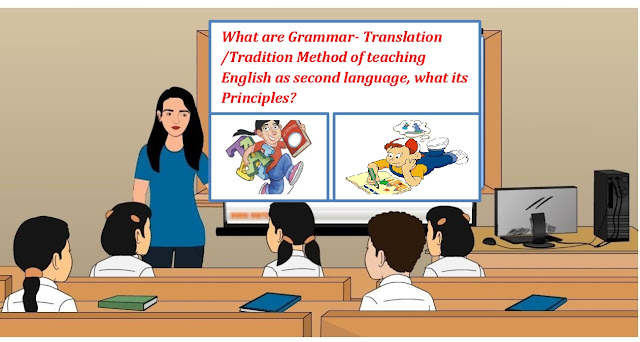What are Grammar- Translation /Tradition Method of teaching English as second language, what its Principles?
What are Grammar- Translation /Tradition Method of teaching English as second language, what its Principles?
·
Grammar-Translation Method of Teaching a English
as Foreign Language
·
The Grammar-Translation Method is not new. It
has had different names, but it has been used by language teachers for many
years, at one time it was called classical method since it was first used in
the teaching of the classical languages.
·
The grammar–translation method is a method of teaching
English as foreign language... Innovative students may be required to translate
whole texts word-for-word.
·
Grammar Translation Method. Occasionally also
known as the Traditional Method, this is a traditional teaching technique that
was used to teach Latin and Greek and was particularly in trend during the 16th
Century. The focus at this time was on the translation of texts, grammar, and memorization
learning of vocabulary.
Method
·
Grammar–translation classes are usually
conducted in the students' native language. Grammar rules are learned
deductively; students learn grammar rules by citation needed and then practice
the rules by doing grammar drills and translating sentences to and from the
target language
·
There is not usually any listening or speaking
practice, and very little attention is placed on pronunciation or any
communicative aspects of the language. The skill exercised is reading, and then
only in the context of translation.
The principles of the Grammar-Translation Method:
1)
A fundamental purpose of learning foreign
language is to be able to read its literature. Literary language is superior to
spoken language. Student’s study of the foreign culture is limited to its
literature and fine arts.
2)
An important objective is for students to be
able to translate each language into the other. If students can translate from
one language into another, they are measured successful language learners.
3)
The skill to interconnect in the target language
is not a aim of foreign language instruction.
4)
The primary skills to be developed are reading
and writing. Little attention is given to speaking and listening and almost
none to pronunciation.
5)
The teacher is the authority in the classroom.
It is very important that students get the correct answer.
6)
It is possible to find native language
equivalence for all target words.
7)
Learning is facilitated through attention to
similarities between the target language and the native language.
8)
It is important for students to learn about the
form of the second language.
9)
Deductive application of an explicit grammar
rule is a useful pedagogical technique.
10)
Language learning provides good mental exercise.
11)
Students should be conscious of the grammatical
rules of the target language.
12)
Use of mother tongue.
13)
Vocabulary items are taught in the form of word
lists.
14)
Elaborate explanations of grammar.
15)
Focus on the morphology and syntax.
16)
Reading of difficult texts early in the course.
17)
Practice focuses on exercises translating
sentences or texts from mother tongue to the target language and vice versa.




Comments
Post a Comment